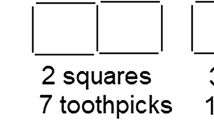Abstract
In order for students to truly understand science, we feel that they must be familiar with select subject matter and also understand how that subject matter knowledge was generated and justified through the process of inquiry. Here we describe a high school biology curriculum designed to give students opportunities to learn about genetic inquiry in part by providing them with authentic experiences doing inquiry in the discipline. Since a primary goal of practicing scientists is to construct explanatory models to account for natural phenomena, involving students in the construction of their own explanatory models provides a major emphasis in the classroom. The students work in groups structured like scientific communities to build, revise, and defend explanatory models for inheritance phenomena. The overall instructional goals include helping students understand the iterative nature of scientific inquiry, the tentativeness of specific knowledge claims (and why they should be considered tentative), and the degree to which scientists rely on empirical data as well as broader conceptual and metaphysical commitments to assess models and to direct future inquiries.
Similar content being viewed by others
REFERENCES
American Association for the Advancement of Science: 1993, Benchmarks for Science Literacy: Project 2061, Oxford University Press, New York.
Black, P.: 1995a, ‘1987 to 1995 — The Struggle to Formulate a National Curriculum for Science in England and Wales’, Studies in Science Education 26, 159-188.
Black, P. (ed.): 1995b, Studies in Science Education, Volume 26, Studies in Education, Yorkshire, UK.
Calley J. & Jungck, J. R.: 1997, ‘Genetics Construction Kit’ (The BioQUEST Library IV, version 1.1B3) [Computer software], The ePress Project, College Park.
Cartier, J.: 1998, ‘Assessment of Explanatory Models in Genetics: Insights into Students' Conceptions of Scientific Models’, paper presented at the annual conference of the National Association for Research in Science Teaching, San Diego, California, April 19–22.
Cartier, J.: 1999, ‘Using a Modeling Approach to Explore Scientific Epistemology with High School Biology Students’, paper presented at the annual conference of the National Association for Research in Science Teaching, Boston, Massachusetts, March 28–31.
Cartier, J. & Stewart, J.: in review, ‘Assessment of Explanatory Models in Genetics: Implications for Building Epistemological Understanding Using a Modeling Approach in the Classroom’.
Darden, L.: 1991, Theory Change in Science: Strategies from Mendelian Genetics, Oxford University Press, New York.
Finkel, E. A. & Stewart, J.: 1994, ‘Strategies for Model-Revision in a High School Genetics Classroom’, Mind, Culture, and Activity: An International Journal 1, 168-195.
Galison, P. & Stump, D. J. (eds.): 1996, The Disunity of Science: Boundaries, Contexts, and Power, Stanford University Press, Stanford.
Giere, R. N.: 1988, Explaining Science: A Cognitive Approach, University of Chicago Press, Chicago, 85.
Han, J.-H.: 1995, ‘The Quest for National Standards in Science Education in Korea’, Studies in Science Education 26, 59-71.
Harrison, A. G. & Treagust, D. F.: 1998, ‘Modelling in Science Lessons: Are There Better Ways to Learn With Models?’, School Science and Mathematics 98(8), 420-429.
Hodson, D.: 1988, ‘Toward a Philosophically More Valid Science Curriculum’, Science Education 72, 19-40.
Johnson, S. K.: 1998, ‘Revising and Assessing Explanatory Models in Genetics: A Comparision of Successful and Less Successful Performance by High School Students’, paper presented at the annual conference of the National Association for Research in Science Teaching, San Diego, April 19–22.
Johnson, S. K. & Stewart, J.: 1990, ‘Using Philosophy of Science in Curriculum Development: An Example from High School Genetics’, International Journal of Science Education 12, 297-307.
Johnson, S. K. & Stewart, J.: 1990, ‘Using Philosophy of Science in Curriculum Development: An Example from High School Genetics’, in M. Matthews (ed.), History, Philosophy, and Science Teaching: Selected Readings, OISE Press, Toronto.
Kitcher, P.: 1984, ‘1953 and All That: A Tale of Two Sciences’, The Philosophical Review 93, 335-373.
Kitcher, P.: 1993, The Advancement of Science: Science without Legend, Objectivity without Illusions, Oxford University Press, New York.
Laudan, L.: 1977, Progress and Its Problems: Towards a Theory of Scientific Growth, University of California Press, Berkeley.
Lehrer, R. & Schauble, L.: (in press), ‘Modeling in Mathematics and Science’, in R. Glaser (ed.), Advances in Instructional Psychology, Erlbaum, Mahwah, NJ.
Mendel, G.: 1865, ‘Experiments on Plant Hybridization’, in J. Peters (ed.), Classic Papers in Genetics, Prentice Hall, NJ, 1959.
National Academy of Sciences: 1995, National Science Education Standards, National Academy of Sciences, Washington D.C.
Rudolph, J. L.: 1998. ‘Reconsidering the Nature of Science as a Curriculum Component: Cognitive Goals and Their Implications for Practice’, paper presented at the annual conference of the National Association for Research in Science Teaching, San Diego, April 19–22.
Schwab, J.: 1964, ‘Structure of the Disciplines: Meanings and Signficances’, in G. W. Ford & L. Pugno (eds.), The Structure of Knowledge and the Curriculum, Rand McNally & Company, Chicago, 189-207.
Stewart, J. & Hafner, R.: 1991, ‘Extending the Concept of “Problem” in Problem-Solving Research’, Science Education 75, 105-120.
Stewart, J., Hafner R., Johnson, S. & Finkel, E.: 1992, ‘Science as Model Building: Computers and High School Genetics’, Educational Psychologist 27, 317-336.
Stewart, J. & Rudolph, J. L.: in review, ‘Rethinking Scientific Problems and Student Problem Solving’.
Wynne, C., Stewart, J. & Passmore, C.: 1998, ‘High School Students' Revising of Meiotic Models’, paper presented at the Annual Conference of the National Association for Research in Science Teaching, San Diego, April 19–22.
Author information
Authors and Affiliations
Rights and permissions
About this article
Cite this article
Cartier, J.L., Stewart, J. Teaching the Nature of Inquiry: Further Developments in a High School Genetics Curriculum. Science & Education 9, 247–267 (2000). https://doi.org/10.1023/A:1008779126718
Issue Date:
DOI: https://doi.org/10.1023/A:1008779126718




